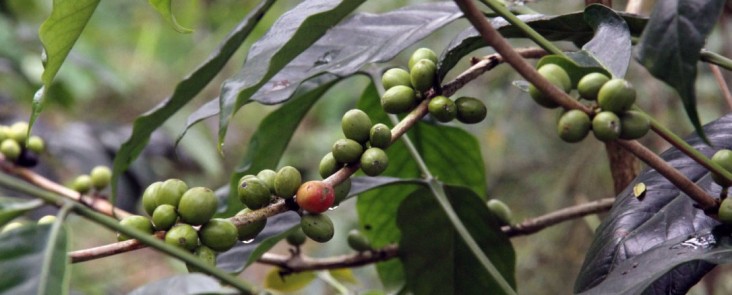Speeches Shim

By James Reindl/Supervisory Development Outreach Communications Officer
LETEFOHO, TIMOR-LESTE -- Coffee is the cash crop king of Timor-Leste’s agricultural exports. At $12 million annually, it’s a mere drop in the pot of the $30.6-billion global coffee market but it’s a major achievement for the tiny Southeast Asia island nation.
Coffee ranks second behind oil in Timor-Leste exports and while both are natural to Timor-Leste and oil funds government operations, it’s coffee that has come the furthest in offering sustainable income to the farmers who grow it.
USAID had a role from the beginning.
“Before, during the Portuguese time, we sold all of our coffee to a Chinese company and during that time we didn’t know exactly how much was the price. We only filled in one box and the price was just based on that,” said coffee grower Miguel Babo. “We thank all the donors that already provided support to us, especially to USAID because for 20 years USAID never forgot us and kept supporting us.”
Timor-Leste, a former Portuguese colony, shares half the island of Timor with Indonesia. Located about 400 miles northwest of Australia, Timor-Leste declared independence in 1975, was invaded and occupied by Indonesia then regained its independence in 2002.
The story of coffee assistance in Timor-Leste actually starts with USAID in 1994. USAID/Indonesia convinced the Indonesian government to lighten control of Timor-Leste’s tiny coffee industry. When the Suharto government loosened its grip, USAID helped the National Cooperative Business Association (NCBA) organize 450 coffee farmers into what is now Cooperatíva Café Timor (CCT), largest coffee exporter in Timor-Leste at least 24,000 farmer members. CCT also is a major employer of women as a percentage of its permanent staff with 40 percent of 580 workers female.
Now, CCT not only exports coffee, it has added high-value spices and other crops. It also runs a string of health clinics providing services to more than 100,000 people. The United States is one of Timor-Leste’s main trading partners and two customers for CCT’s coffee and spices include McCormick & Co. for spice and Starbucks for Timor Fair Trade certified coffee.
In fact, the demand from Starbucks, which bought its first CCT coffee in 1996, exceeds the supply, said Sam Filiaci of NCBA. Filiaci notes that properly pruned coffee trees and further clearing of thick forest to provide adequate sunlight will increase production in the future.
“We would be happy to buy more volume from Timor-Leste if it were available,” said Starbucks spokesperson Molly Spence. “We have highlighted (Timor coffee) in limited single-origin offerings like Starbucks Reserve East Timor Peaberry and Starbucks East Timor Tatamailau. These are coffee series where we have provided some education about the qualities of coffee from different regions.”
USAID’s work with coffee ended in 2013 when the U.S. Department of Agriculture (USDA) began developing the spice industry through CCT. USDA’s project ended in April.
On a recent damp afternoon, Miguel and three other coffee farmers sat sheltered from the rain under a small bamboo hut amid a hillside of coffee trees accessible by a steep set of steps from the road to talk about the changes coffee development brought to their lives.
“I have around two hectares and from one hectare I sometimes get around $500,” said Domingos Santos, a coffee grower for more than 20 years who also grows vegetables to sell in the local market. “That money helps me to take my kids to school, build a new house and also for daily needs.”
CCT’s project manager in Letefoho, Longuinhos Salsinha, has been with CCT since the beginning. He has seen the benefit of U.S. assistance even in the face of some farmers’ reluctance to adopt practices that enhance production, such as pruning trees to encourage fuller growth.
“From the coffee, the farmers are able to receive money and use it right away, not like other revenue such as oil,” he said in his office. “From the coffee, farmers can directly feel what they have done. They plant. They harvest. They receive money and are able to use that money to sustain their family.”
Nearly 20 years after USAID perked up the coffee industry here, a 2012 study of Timor-Leste’s agricultural development by Sweden’s Research Institute of Industrial Economics highlighted how Starbucks’ decision to buy Timorese coffee opened a potential global market.
Miguel agrees and is grateful for the support Timorese coffee farmers have received.
“People in the world know Timor coffee,” he said. “If in the future we stand on our own feet, we will not forget the support and lessons that we got from USAID and that is something we are going to use for the future.”

Comment
Make a general inquiry or suggest an improvement.